

courtesy of the artists
In this article by Anne Klontz, we are invited to investigate the artistic practices of three artists – Ingvild Kristine Reinton, Miriam Johannesson, and Sofia Eriksson – whose work with metal demonstrates the “outermost layer” as a site for transformation and negotiation.
‘People’s conventional structure is often a façade. Under the most rigid conventionality there is often an individual, a human being with original thoughts or inventive fantasy, which he does not dare expose for fear of ridicule, and this is what the writer and artist are willing to do for us.1
The subjective qualities of the façade came directly to my mind in response to the editorial theme of the fifth issue of The Vessel — “the outermost layer”. My favourite example is how Dutch Baroque painters in the 17th century disrupted the senses by painting intricate still lifes, framing luxurious delicacies or grand floral bouquets that were typically meant as a façade referencing moral lessons. In the painting Still Life with Parrots, Jan de Heem (1606 – 1684) painted a scene depicting a table full of exotic food and treasures from faraway places, yet the inclusion of oysters, melons, and shells were warnings that one should practice self-restraint..2
A façade can be a stopping point, yet it is also a filter through which fantasy and reality form narratives where we can contemplate life, and understand or express our thoughts and feelings.
Ingvild Kristine Reinton, Miriam Johannesson, and Sofia Eriksson have invited me into their worlds of inventive fantasies. These artists are dedicated metalsmiths creating unique sculptures from copper and aluminium. They share an interest in challenging the possibilities of the materials’ surfaces by exploring, shaping, hammering, scratching, and polishing them to aesthetic extremes. I bring their practices together through the framework of the façade as the outermost layer, which emerges in different ways through the artists’ ideas and working processes.
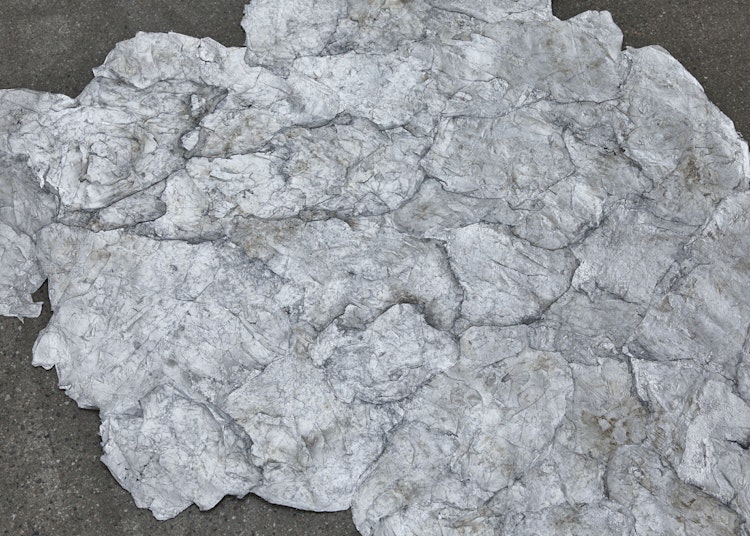
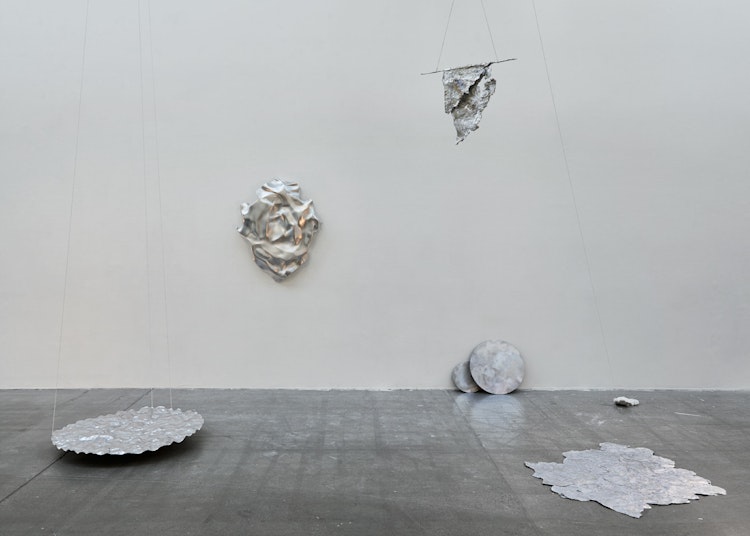
Ingvild Kristine Reinton
There is a subtle, otherworldly presence emanating from the sculptural works of Ingvild Kristine Reinton, who is inspired by unknown realms such as outer space, the depths of the sea, and the unconscious mind. Departing from these expansive and unchartered territories, Reinton grounds her focus in the emotional, and reflects inward to question what she doesn’t know or cannot see. As a result, her inward contemplation of the emotional manifests into organic forms related to ways in which human and non-human entities coexist through growth, decay, and time. Reinton is interested in nature’s structures, patterns, and its ability to reproduce and renew itself, but also in how wind, water, or the changing of the seasons affects these processes.
When creating an artwork, Reinton utilises materials that look dead and lifeless, and transforms them to look alive, specifically copper and clay because they are naturally occurring. At first glance, they each have different properties; when copper is heated it gets soft, and clay gets hard when fired. The fragile characteristics and unstable moments of the materials motivate Reinton and exemplify the core of her practice – the unknown.
Reinton’s most recent work Da du dro (When You Left) is her largest sculpture to date, with dimensions of 200 x 100 cm. Reinton often finds solace through the hammering and heating of copper, as the actions offer a kind of meditative framework. With Da du dro (When You Left), she reflects on notions of care, drawing upon personal experiences as well as inspiration from nature, noticing how nature relies on its different elements to simultaneously give and take what it needs, such as the roots of trees growing to a river’s edge for nourishment. Her observations of these forces – giving and taking – became part of the making process and influenced how the copper plate evolved. As Reinton explains, she wanted the sculpture to embrace the viewer, and this concept is evident in the contrast between its two sides; a softer and more welcoming side curls protectively toward the viewer, while the other side seems to take over and dominate the space. Reinton describes further how the creation of the sculpture was about 'trying to get deeper into myself, trying to understand what’s hiding underneath the façade of the skin. It is like the outer layer of everything; from the surface of a river and what lies underneath it, but also the surface of my own self and the structure of copper – there is a process of revealing involved’.3

The spiral form is often present throughout the artist’s repertoire of works, and when asked about the significance of the shape, Reinton describes it as DNA chains. The complexities of the innate realm of thought and emotions are translated into these spiral strands, and they create a unique vocabulary. Reinton begins all her works with a curiosity for testing the limits of her materials, and the 2022 sculpture titled To retninger (Two Directions) was created through a very physical process of stretching and expanding copper to a point where it nearly began to fall apart. Attempting to expand beyond her fascination for the spiral, To retninger (Two Directions) mimics the curvature of a spine and appears frozen in a twisted state of motion. There are underlying figurative connotations in the work as well; the notion of mentally and emotionally being pulled in two different directions at the same time which, for many of us, creates an internal conflict.
It is moments such as these, or memories from her life growing up, which have influenced why spiral strands repeat in her work, yet they are also evidence of the thoughts existing between the artist and her material. For Reinton, her sculptures are layers she is peeling off so that she can go forward, and in this way, it is her outermost layer that is in a constant state of blossoming.
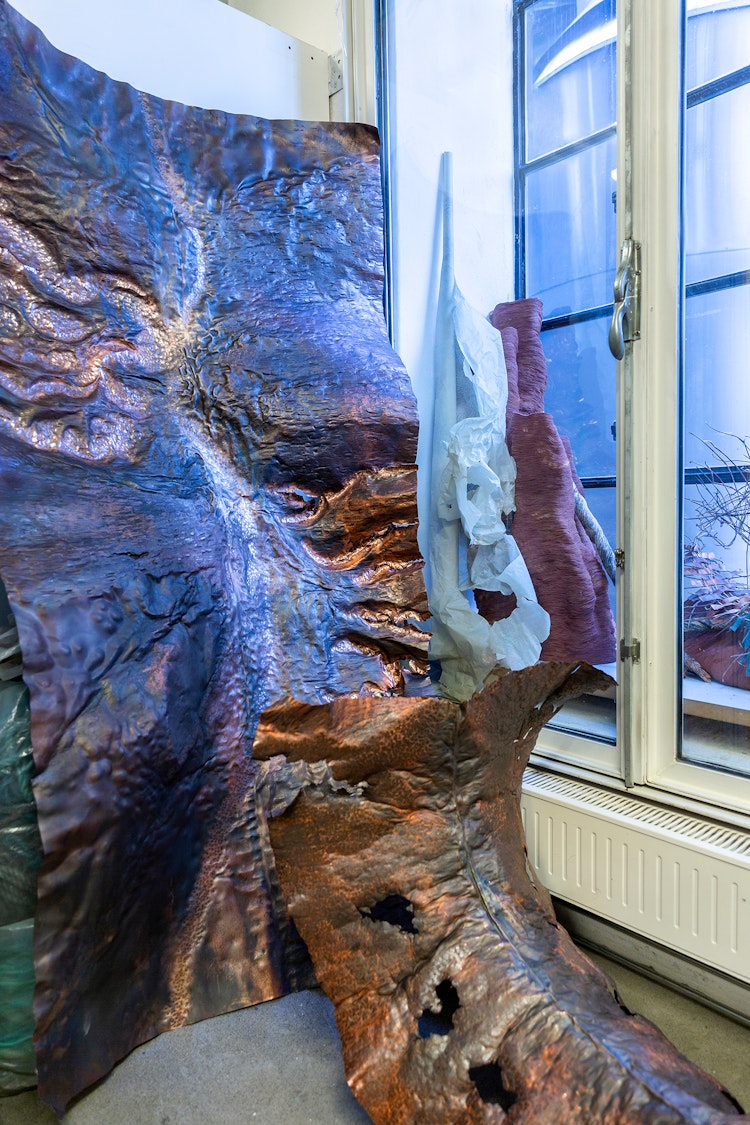
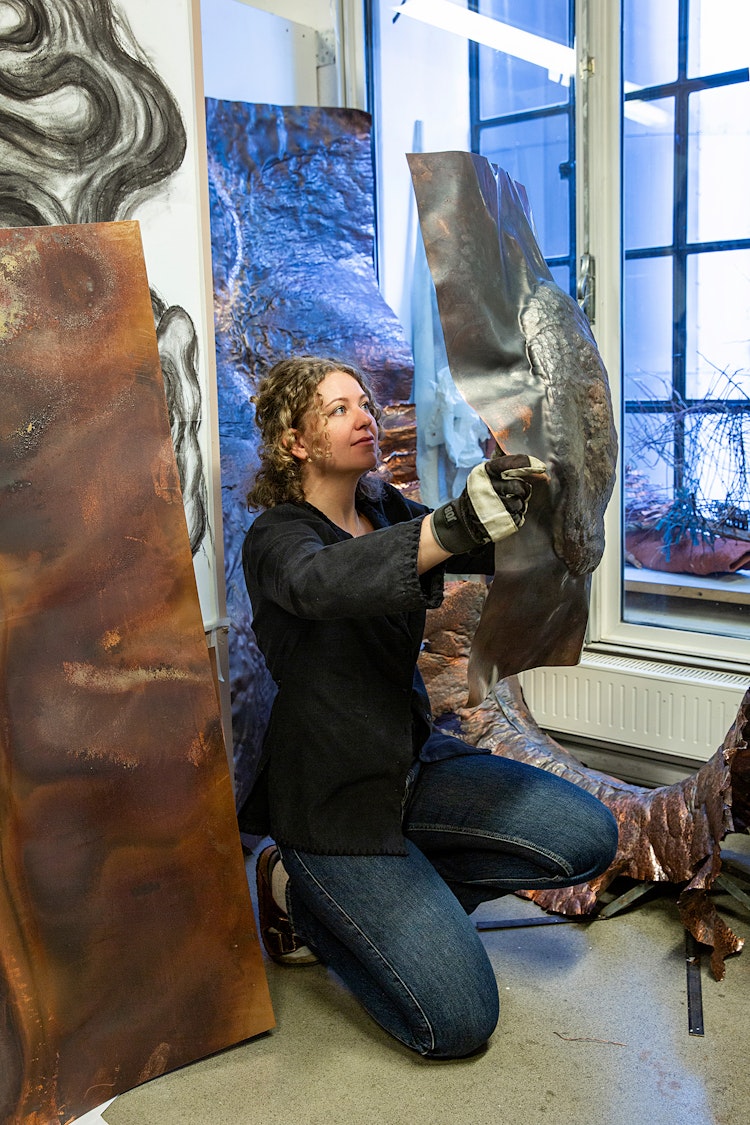
Miriam Johannesson
Miriam Johannesson extracts poetic details from nature’s landscapes and emphasises moments that are often overlooked: the glorious colours of dawn, how a pearl is formed through layers of healing and, as the artist states, ‘How one can see the whole world in a waterdrop.’4
Light, shadow, form, water, and time perform a duality of roles in Johannesson’s practice; they are conceptual elements, as well as material. As Johannesson explains, light and shadows enhance the ephemeral qualities of her sculptures and give them a sense of life.
Serendipity plays an important role in the artist’s working process; she might begin with an idea, but when she makes mistakes or discovers new things about a material, it often fuels her direction. Johannesson’s works are made from various media, but aluminium has been a primary mediator of her ideas. The artist mentions how metal is often described as colourless, which she disagrees with because it reflects colours from light, the space, or from people passing by.
The installation Mystery of Matter and Magic of Presence (2023) emanates a minimalistic atmosphere that is refreshing, calm, and alive. The installation is a work in progress with currently five sculptures that perform their own unique role, yet through the harmony and contrast of each sculpture’s materiality and forms, the installation functions as a complete composition. Within the installation, two works stand out for their conceptual allure: Disguise and The Well.
An illusion of clouds floating in the sky appears across the surfaces of Disguise (2022), which is a work comprised of two round aluminium disks. As one approaches the works, the sense of movement is further exaggerated through the interplay of changing shadows and light. The artist has roughened the work’s surface with a metal brush, creating a painterly effect, and I cannot resist associating Disguise with paintings made in the Romantic era, such as the seascapes of William Turner. The inspiration behind Disguise began with the artist’s interest in the Secchi disk, a tool used to measure the transparency of water. When Johannesson saw how light from the sky reflected in the work, it made her think of heaven and, like the Secchi disk, it was measuring the immeasurable. While a painting can only capture a single moment in time past, Disguise offers a portal into the endless depth and ephemeral qualities of the present.
For Johannesson, round forms are calming, and The Well (2022) also takes the cue of the circle as its form. The aluminium sculpture has been hammered in a way that mimics the pattern of small rippling waves, however the magic in the work happens when lighting around the piece activates the sensation of water’s movement. Capturing the way light refracts on water’s surface is an example of Johannesson’s fascination for the concept of “shimmer”, a quality of light she continuously explores in different materials. She describes shimmer as something both light and dark, and how it’s challenging to define where it starts or ends. ‘In a world where we have never been as lit as today, I find something of the sublime mystery in a shimmering surface.’5 When installed, The Well hangs from thin wires and hovers closely over the floor; it is also animated to gently move. The work initiates an invitation for the viewer to come closer and look into The Well to see what treasures or visions are visible within its depths.
Bringing attention back to Mystery of Matter and Magic of Presence, which Disguise and The Well are from, Johannesson wants her works to perform together, like a symphony, and refer to other senses. There is also a unique space found in the silence between the different works. The rhythm of time and light is always in motion in Johannesson’s works, pulling the attention of the viewer into her world, and encouraging one to find what is hidden underneath the surface of the outermost layer.
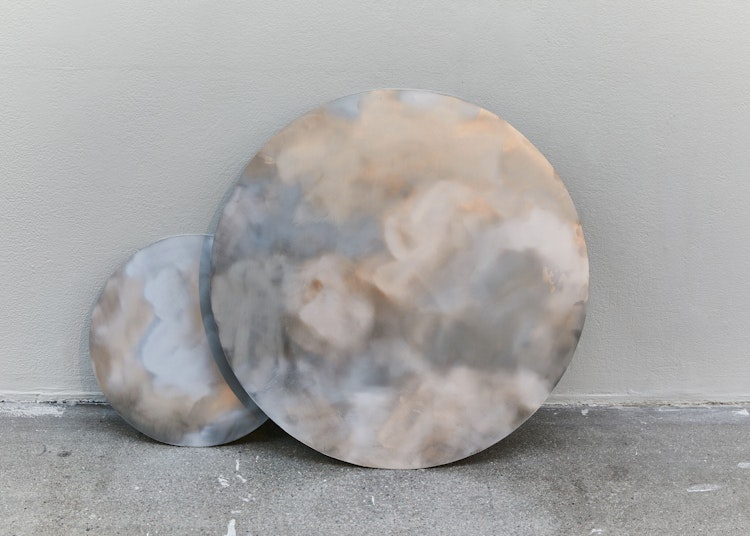
Sofia Eriksson
Sofia Eriksson investigates notions of ornamentation and human/non-human bodies through physical tensions and sculptural forms. The contrast between the softness of a body and the hardness of metal translates into a realm of organic beings. Concept, material, and technique are in constant symbiosis to create a world she is always moving within; her works come to life during the process of making and exploring themes around desire and moments that are alluring and a bit uncomfortable. At first glance, Eriksson’s sculptures are elegant and perfectly executed, and yet, just as a rose is protected by thorns, her sculptures can also be sharp and bear a critical edge. She considers the various translative qualities of her materials: how wood and alabaster can appear like flesh, and how metal can be both sharp and smooth. As Eriksson explains, ‘I’m obsessed with refining material to create a kind of illusion.’6
The sculpture Abstractions of You (2023) is made of nickel-plated copper, and the reflective quality of the shiny metal is like a mirror, welcoming the viewer to become an active element in the work as one’s appearance becomes a distorted pattern across the fleshy folds of the surface. Eriksson describes how mirrors are a symbolic reference to forbidden desires, and Abstractions of You carries a double meaning; it is a critique of the individual self as much as it is commentary on the collective self. Furthermore, the work offers an alternative to the self-portraits of painting or photography in that it will never reveal the truth of one’s reality.
Eriksson often creates multiple works that are variations of one idea, and the objects grow into a shared narrative with similar material qualities, but each carry their own unique form. This way of working stems from the artist’s interest in ornamentation through which repetition and symmetry are used to create structure and order. In her working process, Eriksson is aware of how one forces materials such as metal into a kind of form, while at the same time, she ponders how bodies, whether human or plant, resist this kind of forced structure. Her Metamorphosis series from 2022 is an expression of this process, and the sculptures appear to be in a state of transformation. The artist began the series by looking at flower buds and drawing their outlines several times until they reached the point of ambiguity. The trio of sculptures is shaped from oxidised copper, which creates a darker mood, yet it also gives the effect of a protective membrane covering the muscly forms of something delicate inside. Metamorphosis is a starting point for Eriksson, who wants to further investigate oxidised copper to create more flowery, abstract, and creature-like sculptures.
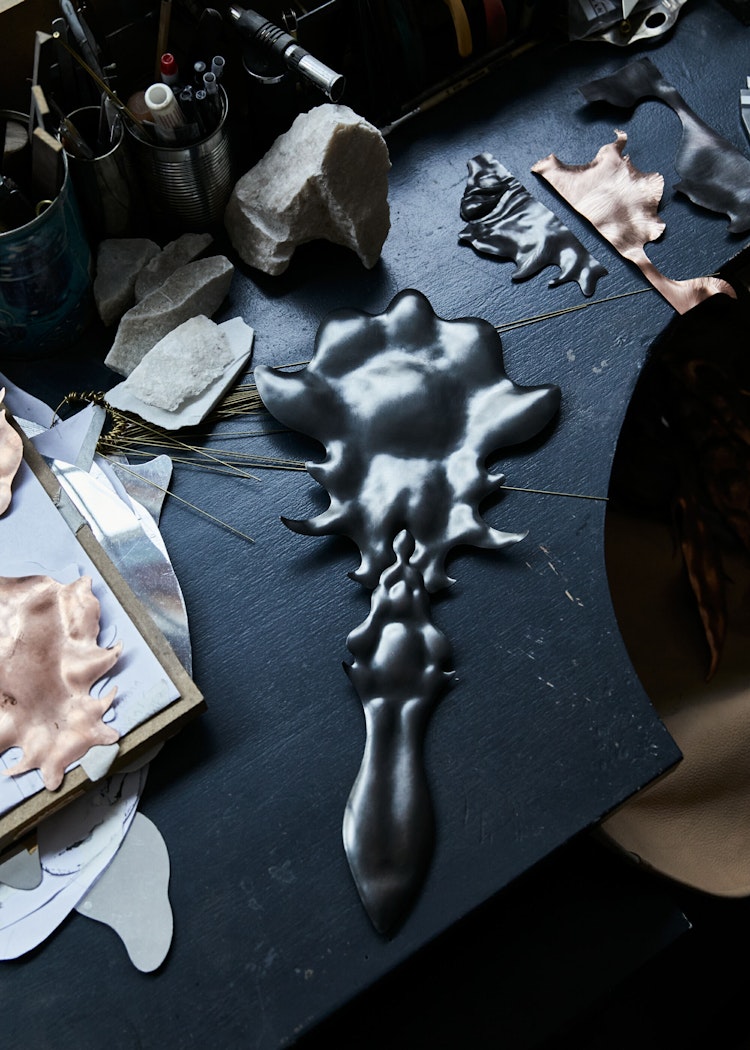
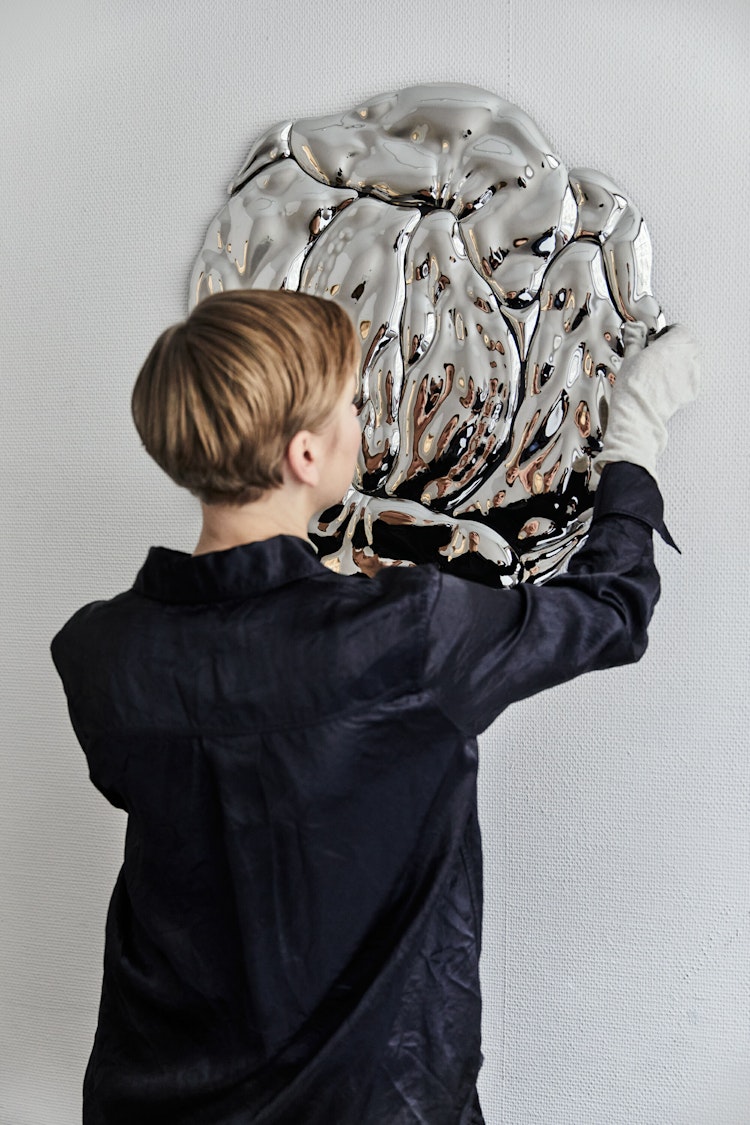
Eriksson emphasises underlying connections to the body in different ways, from the shiny surfaces where reflections are absorbed, to accentuating bodily curves into her sculptural forms. The contrast between the luxurious appearance of polished chrome with the more gothic oxidised metals positions the outermost layer of her sculptures in a performative role, where they ultimately seduce the viewer with the option to feel desire or discomfort.
The outermost layer is an expression of life that extends beyond the edges of the surface, and all three artists reveal this through narratives of the self, identity, and desire, but also through bridging fantasy and reality into mystical and non-human relationships. They demonstrate how the outermost layer is a site for transformation, always in process, forever in motion, and a reality that can be shared. The notion that we must hide behind a façade, or that it functions as a protective layer against societal norms, is refreshingly dismantled – Ingvild Kristine Reinton, Miriam Johannesson, and Sofia Eriksson dare to expose this.